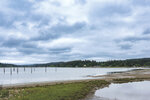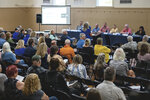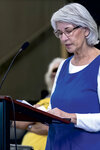


Update: The Key Peninsula Land Use Advisory Council voted 5-2 to recommend approving shoreline permits to expand the geoduck farm with several conditions May 30. The Gig Harbor council voted 3-2 to recommend denying them.
More than 100 people gathered May 22 for the first opportunity to speak publicly about a Taylor Shellfish Co. application to convert part of its current oyster and clam bed farms in Burley Lagoon to geoduck. The joint meeting of both the Key Peninsula and Gig Harbor Land Use Advisory Councils was held at the Key Peninsula Civic Center with 42 speakers participating in-person and via Zoom.
Ty Booth, planner for Pierce County Planning and Public Works, summarized the permitting process, which began in 2014. Erin Ewald, director of regulatory affairs for Taylor, briefly reviewed the history of the Burley Lagoon aquaculture operation, and then individuals were invited to the mic to speak for up to two minutes.
About three quarters of the speakers were Burley Lagoon or Henderson Bay residents. The comments included personal observations of the changes observed over time as Taylor has become a more industrialized operation compared to the previous owner, concerns about the environmental impact of a geoduck monoculture, the effects of light, noise and gear on the quality of life for those who live on the lagoon and worries about the extensive use of plastics.
Booth said there has been a commercial shellfish farm in Burley Lagoon for more than 100 years, established decades before the county created shoreline regulations and permit requirements. Taylor has owned the operation since 2012.
Ewald said the oyster farm as it was operated in the 1950s included oyster processing on site and employed 30-40 people. Taylor currently has three to five full-time employees dedicated to the lagoon and that geoduck conversion would increase them to between five and seven.
The 25.5-acre conversion area, she said, would involve 8.5% of the total 300 acres permitted for aquaculture. Planting would be in patchwork phases using mesh tubes for the first 18 months of a 5-6 year maturation cycle. Exclusion netting over the tubes would likely be used for part of the cycle.
The conversion required an environmental impact statement. The EIS is an extensive review process, Booth said. “It studied sediments, aquatic vegetation, water quality, fish and wildlife, noise, recreation and aesthetics, as well as cumulative effects.
“As allowed by code the applicant did select a consultant and pay for the EIS,” Booth said. “But as required by code it was prepared under the direction of the county and was extensively reviewed by the county before it was issued.”
The EIS concluded that the conversion would have a mild to moderate impact on the lagoon and is under appeal.
The Shoreline Management Act gives aquaculture preferential treatment as a water-dependent use, Booth said. But it also gives preference to individual homes, recreation and public access. Those competing preferences can lead to conflict. The act states that the scale of an aquaculture operation shall be in proportion to the surface area and configuration of the affected water body.
“This is the main issue at hand,” Booth said. “Would the proposal, in conjunction with the existing farm, monopolize the lagoon to the detriment of everything else?”
For those who spoke, the answer to that question was a resounding yes.
Several spoke about the impact of tens of thousands of plastic pipes per acre and the effects of planting and harvesting on eelgrass, forage fish and salmon. Others raised concerns about microplastics and their harm to wildlife and humans.
Burley Lagoon resident Laurie Kennedy said a recent king tide brought large quantities of equipment debris ashore. Another speaker, citing climate change, worried that such incidents would become more common in the future.
John Nichols of Lakebay compared the dangers of monoculture in geoduck farming to those of the salmon and forestry industries, with resulting risks from the loss of both genetic- and biodiversity. Charlie Walters, also of Lakebay, shared his experience when a British Columbia oyster farm was converted to geoduck. Eelgrass disappeared, tubes littered the beach, and it was an ugly mass of white plastic, he said.
Many who have lived on the lagoon for decades said that since Taylor took over the operation has become more industrialized. Wendy Ferrell, a fifth-generation resident, harkened back to times when there were no nets or cages.
“Burley Lagoon is not very wide,” said Bruce Dowdy. “We hear everything, the voices, the lights.” He is concerned that there will be more noise with geoduck harvesting requiring generators and occurring throughout the year. “It feels like a trespass,” said John Ferrell.
Laura Hendricks, executive director of Coalition to Save Puget Sound, said the number of acres farmed in the lagoon has expanded under Taylor’s watch — from 5 in 1998 to 50 in 2007 to 175 acres in 2011. She also raised a legal objection to the conversion. Unless geoducks had been planted in the subtidal area before the end of 2001, she said, they could not be planted now.
“It’s the public’s opportunity to speak their concerns,” Ewald said of the meeting. “But it was hard to listen to comments that have been summarily dismissed by regulating agencies and hearings boards on multiple occasions.”
The public comments, part of the process for the required shoreline substantial development and conditional use permits, will be considered by the advisory councils when they make their recommendations to the Pierce County hearing examiner.
Public comments will be allowed at the hearing examiner meeting, which was not scheduled as of press time. The hearing examiner will also consider the appeal filed objecting to the EIS determination.
The Washington State Department of Ecology will make the final decision.
UNDERWRITTEN BY THE FUND FOR NONPROFIT NEWS (NEWSMATCH) AT THE MIAMI FOUNDATION, THE ANGEL GUILD, ADVERTISERS, DONORS AND PEOPLE WHO SUPPORT INDEPENDENT, NONPROFIT LOCAL NEWS